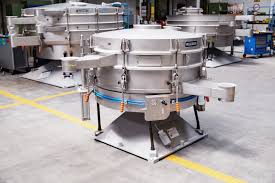
Introduction
The tumbler screener is a highly effective screening device used for the separation and classification of materials in various industries. It is known for its ability to handle large volumes of materials gently and efficiently, making it a popular choice for applications requiring precise classification. This article explores the key features, advantages, and diverse applications of the tumbler screener.
What is a Tumbler Screener?
A tumbler screener, often referred to as a tumbler screening machine, operates on a principle similar to hand screening. It uses a circular, tumbling motion to move materials across a series of screens, which allows for effective separation based on particle size and other characteristics. The design ensures thorough and accurate screening, making it suitable for a wide range of applications.
Key Features of Tumbler Screeners
- Circular Tumbling Motion:
-
- Description: Tumbler screeners use a rotating screen deck to create a tumbling action.
- Function: This motion helps in achieving effective screening by allowing particles to pass through various layers of mesh screens.
- Multiple Decks:
-
- Description: Many tumbler screeners are equipped with multiple decks.
- Function: Facilitates separation at different stages, improving classification efficiency and versatility.
- Adjustable Vibration:
-
- Description: Some models come with adjustable vibration settings.
- Function: Allows users to control the intensity and direction of vibration to match specific material characteristics.
- High-Quality Screen Mesh:
-
- Description: The screen mesh is typically made from durable materials such as stainless steel.
- Function: Ensures effective separation while resisting wear and tear.
- Large Screening Area:
-
- Description: Tumbler screeners often feature a large surface area for screening.
- Function: Provides high-capacity processing and efficiency, suitable for handling large volumes of material.
- Compact and Ergonomic Design:
-
- Description: Designed to be space-efficient and user-friendly.
- Function: Integrates easily into existing production lines and processes.
Advantages of Tumbler Screeners
- High Efficiency:
-
- Benefit: Provides high-efficiency separation and classification of materials, ensuring high product quality and consistency.
- Versatility:
-
- Benefit: Capable of handling a diverse range of materials, including powders, granules, and coarse particles.
- Gentle Handling:
-
- Benefit: The tumbling action minimizes material degradation, making it ideal for fragile or high-value materials.
- Large Capacity:
-
- Benefit: With a large screening area and multiple deck options, tumbler screeners can handle high volumes of material.
- Customizable Performance:
-
- Benefit: Adjustable settings for vibration and screen configurations allow for tailored performance based on specific needs.
- Low Maintenance:
-
- Benefit: Durable construction and easy-to-clean components result in reduced maintenance requirements.
Applications of Tumbler Screeners
- Food Industry:
-
- Application: Screens and classifies food powders, granules, and ingredients to ensure product consistency and quality.
- Pharmaceutical Industry:
-
- Application: Handles pharmaceutical powders and granules, providing precise separation to meet rigorous quality standards.
- Chemical Industry:
-
- Application: Separates and classifies various chemical powders and granules, enhancing material handling and processing.
- Mining and Aggregates:
-
- Application: Used for separating and classifying minerals, ores, and aggregates, improving processing efficiency and material quality.
- Recycling:
-
- Application: Screens and sorts recyclable materials such as plastics, metals, and paper, facilitating efficient recycling processes.
- Plastic Industry:
-
- Application: Separates plastic pellets and granules to ensure uniformity in plastic production.
Choosing the Right Tumbler Screener
When selecting a tumbler screener, consider the following factors:
- Material Characteristics:
-
- Consideration: Evaluate the properties of the material, including particle size, density, and flow behavior.
- Screen Size and Capacity:
-
- Consideration: Determine the appropriate screen size and capacity based on material volume and separation needs.
- Deck Configuration:
-
- Consideration: Choose the number of decks and mesh sizes based on application requirements and material specifications.
- Adjustability:
-
- Consideration: Look for features that allow for adjustment of vibration settings and screen motion to optimize performance.
- Durability:
-
- Consideration: Ensure the screener is made from high-quality, durable materials to withstand operational demands and provide long-term reliability.
- Cost and Value:
-
- Consideration: Assess the cost in relation to the features, performance, and potential return on investment.
Maintenance and Care
To maintain optimal performance of a Tumbler Screener
- Routine Inspections:
-
- Action: Regularly inspect the screen mesh, rotating mechanism, and other components for wear and damage.
- Cleaning:
-
- Action: Clean the screen deck and other parts regularly to prevent material buildup and ensure efficient operation.
- Lubrication:
-
- Action: Lubricate moving parts as needed to minimize friction and wear.
- Adjustment and Calibration:
-
- Action: Periodically adjust vibration settings and screen configurations to maintain peak performance.
- Operator Training:
-
- Action: Train operators on proper handling, maintenance, and troubleshooting to ensure effective and efficient use.
Future Trends in Tumbler Screeners
- Technological Advancements:
-
- Trend: Integration of advanced technologies such as automation, real-time monitoring, and predictive maintenance for enhanced efficiency.
- Customization and Flexibility:
-
- Trend: Growing demand for customizable solutions to address specific industry needs and material characteristics.
- Energy Efficiency:
-
- Trend: Development of energy-efficient designs to reduce operational costs and environmental impact.
- Sustainability:
-
- Trend: Focus on sustainable manufacturing practices and materials to meet environmental regulations and corporate sustainability goals.
- Enhanced User Experience:
-
- Trend: Innovations aimed at improving user interfaces and control systems for better ease of use and maintenance.
- Integration with Industry 4.0:
-
- Trend: Adoption of Industry 4.0 technologies for improved integration, automation, and data analytics.
Conclusion
The tumbler screener is an effective and versatile solution for material separation and classification. Its high efficiency, versatility, and gentle handling make it suitable for a wide range of applications. Understanding its features, advantages, and applications helps businesses make informed decisions when selecting this equipment. As technology advances, tumbler screeners will continue to evolve, offering improved performance and customization options. Partnering with a reputable manufacturer ensures access to high-quality equipment and support, contributing to optimized material processing and operational success.

